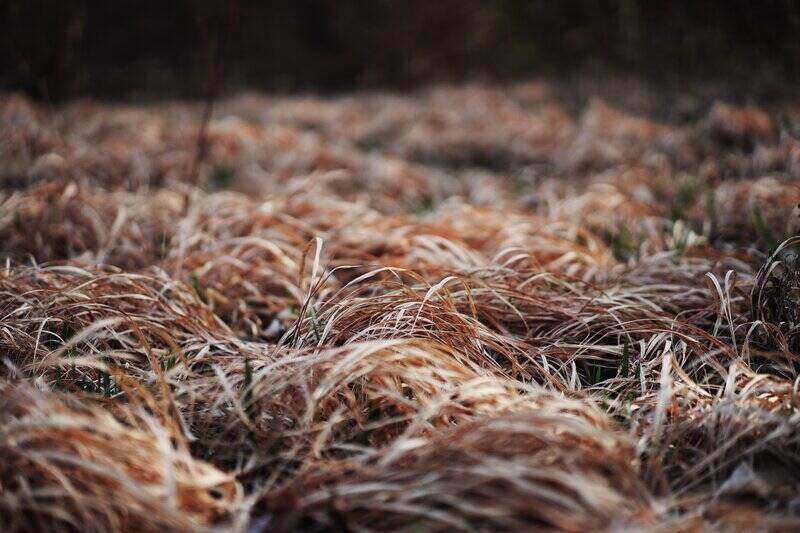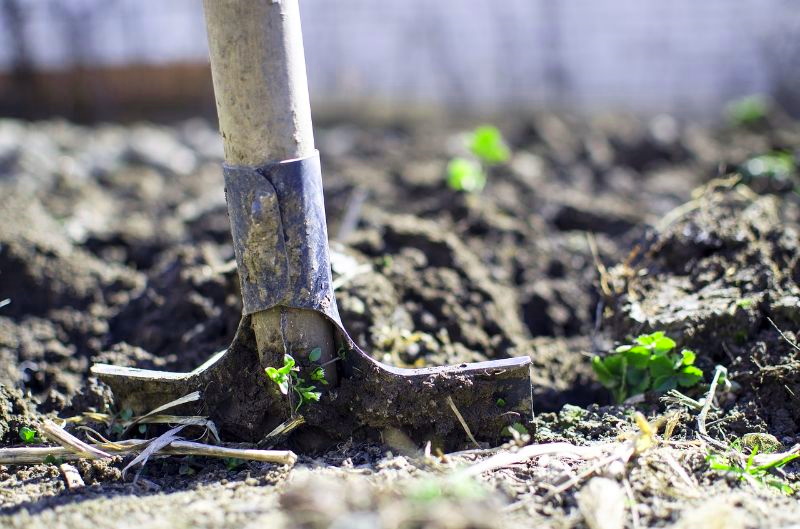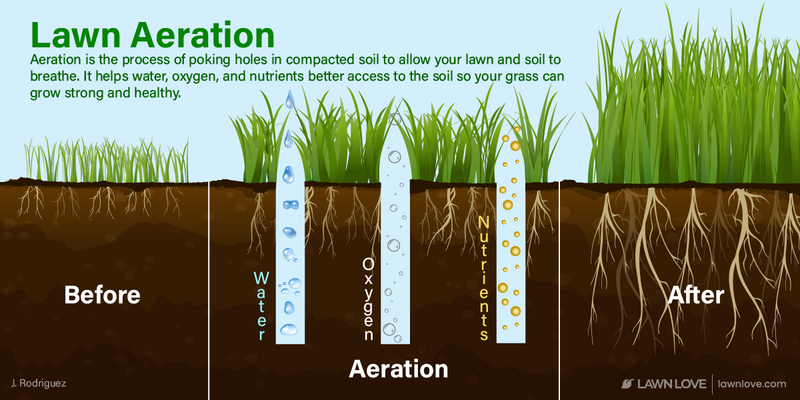
If your brown lawn isn’t improving with water and fertilizer, it might be suffering from compacted soil. But how can you tell if you have compacted soil and not some other grass ailment? From difficulty digging to poor drainage, compacted soil has a few tell-tale signs.
We’ll show you how to fix compacted soil so that your lawn can return to looking healthy and beautiful. Compacted soil does have a few benefits, but when it comes to the health of your turfgrass, it’s a disadvantage.

What is soil compaction?
Soil is made up of mineral particles, organic matter, living organisms, and pore space. This pore space allows water, oxygen, and nutrients to move through the soil with ease, creating healthy root systems and a thriving ecosystem.
Soil compaction occurs when soil is pressed together, reducing the pore space. When soil is compacted, the water, oxygen, and nutrients can’t penetrate the dense soil. Plant roots are unable to spread, and earthworm activity decreases.

Signs your lawn has compacted soil
Oxygen, water, and nutrients can’t access the lawn’s root system when the soil is compacted. As a result, the lawn struggles to grow, its health eventually declines, and it becomes susceptible to pests, diseases, and weeds.
Here are some common signs of soil compaction in the lawn:
- The grass is brown, yellow, or off-colored.
- The grass is thin or has patches of bare soil where no grass can grow.
- The grass grows slowly during its active growing season.
- Low areas of the lawn develop puddles after irrigation or rain.
- Water rolls off high areas of the lawn.
- Weeds, diseases, or pests invade the lawn.
- The lawn develops excessive thatch.
- The lawn has obvious signs of foot traffic, such as a bare path where people or pets frequently walk.
- Trees have exposed surface roots. Take note that some trees naturally have shallow roots, such as ash trees and some maple trees.
Remember that some of these symptoms may signify another problem with your yard, such as drought or low fertility. We cover other possibilities later in this article.

How to test for compacted soil
Pierce the ground with a shovel or screwdriver to test the hardness of the soil. Digging into the ground is always a bit difficult, but if the tool won’t budge despite added energy and muscle, the soil is likely compacted.
Perform this test in a few different areas, as some underground obstacles may be blocking the tool, such as rocks.
If you’re able to dig up the compacted soil, you’ll notice that the soil has little to no pore space and that the grass has a shallow root system.
Remember: You must call 811 before you dig in the yard. A utility company will send a pro to mark where underground utilities exist. Otherwise, you might damage a utility line by accident.
What causes soil compaction?
You should enjoy your yard, but maybe you’ve been hosting one too many barbecues or badminton tournaments. Anything that presses the soil together and eliminates pore space can cause soil compaction, such as:
- High foot traffic: If people or pets frequently walk over the same area, the traffic can lead to soil compaction.
- Wet soil: Amending wet or moist soil or moving heavy equipment over it, such as a lawn mower, can cause it to compact.
- Parking cars on the lawn: The next time you host a barbecue, ask guests to park on the road instead of on your grass.
- Recent construction on the property: Heavy machinery can put significant pressure on the soil.
- Heavy rains: If you’ve been getting a lot of heavy rains, the falling water can press the soil tightly together.
- Over-tilling the soil: A good soil structure has pea-sized lumps of soil with ample pore space. But frequent tilling of the same area breaks the lumps down into small soil particles and eliminates pore space. The next time the soil becomes wet, the tiny particles will form muddy, compact soil.
- Mixing sand with clay soil: According to the Michigan State University Extension, mixing sand with clay soil can give the soil a concrete quality.

How to make your soil less compact
The best way to remedy soil compaction is to perform core aeration on the lawn. Core aeration is the process of removing plugs of soil from the ground. These plugs are approximately 2 to 3 inches long, three-quarter inches in diameter, and 3 to 4 inches apart.
The small holes in the ground allow water, oxygen, and nutrients to penetrate the soil and access the grass roots. The holes also allow the roots to grow and expand into the open space.
Visit your local home improvement store to learn about aerator rental options. Some stores offer hourly, daily, and weekly rentals of core aerators.
Pro Tip: You can enrich your soil by topdressing with compost after aeration.
Other reasons for unhealthy grass
Some symptoms of compacted soil mimic the symptoms of other lawn issues. If your lawn appears off-colored, has patches, or grows slowly, it may be experiencing the following:
- Wrong grass type: You may have planted a grass type that can’t grow well in your area. Warm-season grasses grow best in the South, and cool-season grasses grow best up North. If you live between the North and South, you can grow either type of grass.
- Dormancy: Lawns turn tannish-brown when they enter dormancy. Dormancy is normal for the lawn and doesn’t negatively affect its health.
- Drought: If your lawn doesn’t get enough water, it will struggle to grow.
- Low fertilization: A healthy lawn needs healthy soil. Soil with low fertility can slow down grass growth.
- Over-fertilization: Applying too much fertilizer to your lawn can damage your grass.
- Excessive thatch: Like compacted soil, thatch can prevent water, oxygen, and nutrients from penetrating the soil surface.
- Pests: Grubs, chiggers, and other pests can jeopardize the health of your lawn.
- Lawn diseases: Fungal diseases like brown patch and dollar spot can cause significant damage to the yard.
- Improper mowing: Poor mowing techniques can be stressful for your turf.
- Improper watering: Watering too often and for short periods discourages healthy root growth.
Leave lawn aeration to the professionals
Compacted soil might ruin your lawn’s curb appeal, but you needn’t let it ruin your weekend. Spend your free time planning the next pool party while a local lawn care professional aerates the soil for you.
Why not hand over all your lawn care to a pro? From mowing the grass to improving soil health, a lawn care expert can revive your lawn’s health and beauty.
Main Photo Credit: USDA Natural Resources Conservation Service | Wikimedia Commons | CC BY-SA 4.0